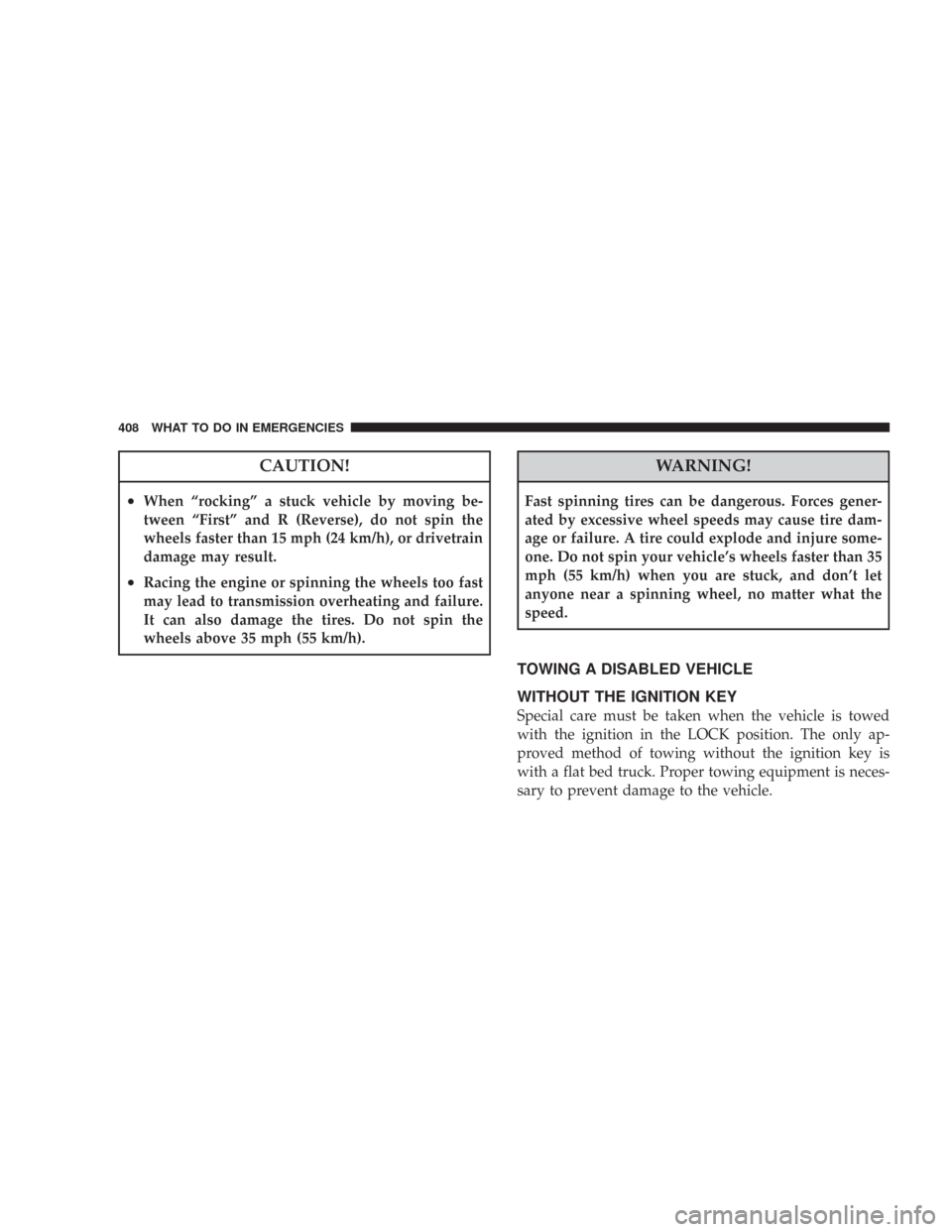Page 407 of 519

NOTE:For vehicles equipped with ESP, refer to�Syn-
chronizing ESP�under�Electronic Stability Program�in
Section 5 of this manual if the ESP/BAS light (in the
instrument cluster) remains on continuously after start-
ing the engine of the vehicle with the discharged battery.
8. When removing the jumper cables, reverse the above
sequence exactly. Be careful of the moving belts and fan.
WARNING!
Any procedure other than above could result in:
1. Personal injury caused by electrolyte squirting out
the battery vent;
2. Personal injury or property damage due to battery
explosion;
3. Damage to charging system of booster vehicle or
of immobilized vehicle.
FREEING A STUCK VEHICLE
If your vehicle becomes stuck in mud, sand, or snow, it
can often be moved by a rocking motion. Turn your
steering wheel right and left to clear the area around the
front wheels. Then shift back and forth between Reverse
and Drive. Usually the least accelerator pedal pressure to
maintain the rocking motion without spinning the
wheels is most effective.
NOTE:Turn off the Electronic Stability Program (ESP)
— if equipped, or Traction Control System (TCS) — if
equipped before rocking the vehicle. For details, refer to
“Electronic Stability Program” or “Traction Control Sys-
tem” in this manual.
WHAT TO DO IN EMERGENCIES 407
6
Page 408 of 519

CAUTION!
•When “rocking” a stuck vehicle by moving be-
tween “First” and R (Reverse), do not spin the
wheels faster than 15 mph (24 km/h), or drivetrain
damage may result.
•Racing the engine or spinning the wheels too fast
may lead to transmission overheating and failure.
It can also damage the tires. Do not spin the
wheels above 35 mph (55 km/h).
WARNING!
Fast spinning tires can be dangerous. Forces gener-
ated by excessive wheel speeds may cause tire dam-
age or failure. A tire could explode and injure some-
one. Do not spin your vehicle’s wheels faster than 35
mph (55 km/h) when you are stuck, and don’t let
anyone near a spinning wheel, no matter what the
speed.
TOWING A DISABLED VEHICLE
WITHOUT THE IGNITION KEY
Special care must be taken when the vehicle is towed
with the ignition in the LOCK position. The only ap-
proved method of towing without the ignition key is
with a flat bed truck. Proper towing equipment is neces-
sary to prevent damage to the vehicle.
408 WHAT TO DO IN EMERGENCIES
Page 411 of 519
MAINTAINING YOUR VEHICLE
CONTENTS
�2.7L Engine Compartment................414
�3.5L Engine Compartment................415
�5.7L Engine Compartment................416
�Onboard Diagnostic System — OBD II........417
▫Loose Fuel Filler Cap..................417
�Emissions Inspection And Maintenance
Programs............................418
�Replacement Parts......................419
�Dealer Service.........................420�Maintenance Procedures..................420
▫Engine Oil..........................421
▫Engine Oil Filter......................425
▫Drive Belts — Check Condition And Tension . . 425
▫Spark Plugs.........................426
▫Engine Air Cleaner Filter................426
▫Fuel Filter..........................426
▫Catalytic Converter....................427
▫Maintenance-Free Battery................428
7
Page 413 of 519
▫Low Beam Headlight, High Beam Headlight,
Park/Turn Light, Inner Park Light, And
Outer Park Light – 300 Models............460
▫Low Beam Headlight, High Beam Headlight,
And Park/Turn Light – 300C.............462
▫Backup Light, Side Marker Light, And Tail/
Stop Turn Light — 300 Models............465
▫Tail/Stop, Tail, Turn Signal Light, And Backup
Light — 300C Models..................468▫License Light........................472
�Fluids And Capacities...................473
�Fluids, Lubricants, And Genuine Parts........475
▫Engine.............................475
▫Chassis............................476
MAINTAINING YOUR VEHICLE 413
7
Page 414 of 519
2.7L ENGINE COMPARTMENT
1 — Fuses (Front Power Distribution Center) 6 — Air Cleaner Filter
2 — Engine Oil Dipstick 7 — Coolant Pressure Cap
3 — Brake Fluid Reservoir Access Cover 8 — Engine Oil Fill
4 — Coolant Bottle 9 — Remote Jump-Start Positive Battery Post
5 — Power Steering Fluid 10 — Washer Fluid Bottle 414 MAINTAINING YOUR VEHICLE
Page 415 of 519
3.5L ENGINE COMPARTMENT
1 — Fuses (Front Power Distribution Center) 6 — Coolant Bottle
2 — Air Cleaner Filter 7 — Engine Oil Fill
3 — Brake Fluid Reservoir Access Cover 8 — Engine Oil Dipstick
4 — Coolant Pressure Cap 9 — Washer Fluid Bottle
5 — Power Steering Fluid 10 — Remote Jump-Start Positive Battery PostMAINTAINING YOUR VEHICLE 415
7
Page 416 of 519
5.7L ENGINE COMPARTMENT
1 — Fuses (Front Power Distribution Center) 6 — Air Cleaner Filter
2 — Coolant Pressure Cap 7 — Engine Oil Fill
3 — Brake Fluid Reservoir Access Cover 8 — Engine Oil Dipstick
4 — Coolant Bottle 9 — Remote Jump-Start Positive Battery Post
5 — Power Steering Fluid 10 — Washer Fluid Bottle 416 MAINTAINING YOUR VEHICLE
Page 417 of 519

ONBOARD DIAGNOSTIC SYSTEM — OBD II
Your vehicle is equipped with a sophisticated onboard
diagnostic system called OBD II. This system monitors
the performance of the emissions, engine, and automatic
transmission control systems. When these systems are
operating properly, your vehicle will provide excellent
performance and fuel economy, as well as engine emis-
sions well within current government regulations.
If any of these systems require service, the OBD II system
will turn on the “Malfunction Indicator Light.” It will
also store diagnostic codes and other information to
assist your service technician in making repairs. Al-
though your vehicle will usually be drivable and not
need towing, see your dealer for service as soon as
possible.CAUTION!
Prolonged driving with the “Malfunction Indicator
Light” on could cause further damage to the emission
control system. It could also affect fuel economy and
driveability. The vehicle must be serviced before any
emissions tests can be performed.
If the “Malfunction Indicator Light” is flashing
while the engine is running, severe catalytic con-
verter damage and power loss will soon occur. Im-
mediate service is required.
Loose Fuel Filler Cap
If the vehicle diagnostic system determines that the fuel
filler cap is loose, improperly installed, or damaged, a
“Check Gascap” message will display in the Electronic
Vehicle Information Center (EVIC) — if equipped. If this
occurs, tighten the fuel filler cap properly and press the
MAINTAINING YOUR VEHICLE 417
7